
94% of researchers rate our articles as excellent or good
Learn more about the work of our research integrity team to safeguard the quality of each article we publish.
Find out more
ORIGINAL RESEARCH article
Front. Digit. Humanit., 05 April 2018
Sec. Digital Literary Studies
Volume 5 - 2018 | https://doi.org/10.3389/fdigh.2018.00004
 Greta Franzini1
Greta Franzini1 Mike Kestemont2*
Mike Kestemont2* Gabriela Rotari1
Gabriela Rotari1 Melina Jander1
Melina Jander1 Jeremi K. Ochab3
Jeremi K. Ochab3 Emily Franzini1,4
Emily Franzini1,4 Joanna Byszuk5
Joanna Byszuk5 Jan Rybicki3
Jan Rybicki3
This article presents the results of a multidisciplinary project aimed at better understanding the impact of different digitization strategies in computational text analysis. More specifically, it describes an effort to automatically discern the authorship of Jacob and Wilhelm Grimm in a body of uncorrected correspondence processed by HTR (Handwritten Text Recognition) and OCR (Optical Character Recognition), reporting on the effect this noise has on the analyses necessary to computationally identify the different writing style of the two brothers. In summary, our findings show that OCR digitization serves as a reliable proxy for the more painstaking process of manual digitization, at least when it comes to authorship attribution. Our results suggest that attribution is viable even when using training and test sets from different digitization pipelines. With regards to HTR, this research demonstrates that even though automated transcription significantly increases the risk of text misclassification when compared to OCR, a cleanliness above ≈ 20% is already sufficient to achieve a higher-than-chance probability of correct binary attribution.
Studies show that researchers working on data analysis projects can spend up to 80% of project time pre-processing data and only 20% addressing their research question(s) (Wickham, 2014; Press, 2016). This imbalance suggests that scholars operate under the assumption that the time invested in pre-processing is directly proportional to the quality of the results—in other words, that any high quality analysis is intolerant to low quality data.
This research1 builds upon studies that have explored acceptable degrees of digitization noise in computational, style-based authorship attribution,2 in an effort to produce a model of Jacob and Wilhelm Grimm’s3 handwriting, and identify authorship in a body of correspondence. Specifically, we ran the analyses on an uncorrected OCR’ed version of the letters derived from a print edition, and on an uncorrected HTR’ed version derived from digital images of the handwritten documents. The two versions introduce substantially different processing noise, giving us an effective means of comparison.
This article addresses the following research question: to which degree does the OCR and HTR noise affect the study of the individual stylome (Halteren et al., 2005) of the Grimm brothers? With this work, we explore the possibility offered by current technologies to better understand the writing styles of Jacob and Wilhelm Grimm. The challenges we face include the handling of textual noise generated through the digital transformation of the source texts, as well as the diversity and quantity of the data at our disposal.
This article is structured as follows: Sections 1 and 2 discuss the motivation behind the project and present related work; in Section 3 we introduce our materials, while in Section 4 we describe the digitization of these materials, the computational task of attributing authorship on the basis of the uncorrected digitized data, and discuss the results of the study; finally, Section 5 provides a summary of the results and suggestions for follow-up research.
Today, researchers working with texts available on the web are often confronted with unstructured and noisy data. Subramaniam et al. (2009) identified two types of noisy text: noise introduced during the generation process of a text (e.g., spelling errors, non-standard word forms, special characters, intentional abbreviations, grammatical mistakes, etc.) and noise introduced during the conversion process of a text to another form (i.e., through digitization or digital transformation) [(Subramaniam et al., 2009), p. 115]. Researchers working with literary texts available on the web typically deal with the latter type of noise—that caused by a text’s transformation from its handwritten or printed form into machine-editable text via Optical Character or Handwritten Text Recognition (OCR and HTR, respectively). On historical texts, the recognition accuracy of OCR engines on the character level can reach 95% or more (Fink et al., 2017), but it may also perform poorly depending on the type of historical source (critical editions of classical texts as opposed to incunabula); for HTR, the rate ranges between 80 and 90% with respect to clean handwriting [(Agarwal et al., 2007), p. 5]. Lopresti (2009) discusses the effects of OCR errors on Information Retrieval (IR) and Natural Language Processing (NLP), and while there are methods in place to measure noise and recognition accuracy [(Subramaniam et al., 2009), p. 117–118], as well as semi-automatic applications to help correct the noise and tell historical spelling apart from machine errors (Vobl et al., 2014),4 studies show that researchers working on data analysis projects can spend up to 80% of project time preparing data (Wickham, 2014).
In an effort to cut down on data pre-processing, scholars have tested algorithmic tolerance to noise. For instance, Agarwal et al. (2007) describe a series of experiments designed to better understand the effect of feature noise on automatic text classification algorithms, and have found that their classification accuracy tolerated up to 40% of introduced feature noise. In stylometry, Eder demonstrated the robustness of a number of authorship attribution methods across a variety of feature types in English, German, Polish, Ancient Greek, and Latin prose texts. His study showed that although noise tolerance varied across languages, even a 20% damage in the text did not significantly decrease the performance of authorship attribution [(Eder, 2013), p. 612]. Many present-day approaches to computational authorship attribution operate on very local features, such as the frequencies of word unigrams or character n-grams (Kjell, 1994; Stamatatos, 2009; Kestemont, 2014). These features are typically very common and well-distributed throughout texts (and much less sparse than, for instance, content words), which helps to explain why such feature categories are robust to the injection of significant levels of seemingly stochastic noise. Additionally, the use of regularization techniques (for example, with support vector machines) might prevent classifiers from overfitting on such noisy features. To the best of our knowledge, no systematic study thus far has “modelled out” such noise, although scholars routinely normalize their attribution through the use of NLP software (Juola, 2008; Koppel et al., 2009; Stamatatos, 2009).
In authorship attribution and stylometric analyses, a contributing factor to the reliability of the results is sample size or, in other words, the number of words analyzed to infer an author’s style. In an article devoted to the topic, Eder, contrary to his previous claims (Eder, 2015), places the minimum acceptable sample size for authorship attribution as low as 2,000 words if the authorial fingerprint in the text is strong [(Eder, 2017), p. 223]. It follows that, while large samples are preferable, small samples can also, in certain cases, produce accurate results.
To investigate the effect of OCR and HTR noise on analyses in stylometric authorship attribution, we chose to work with a body of correspondence belonging to the Grimm family. The Grimm corpus, in fact, is well suited to this task for its diachrony and dual existence as handwritten documents and as a printed edition.
In October 2015, we acquired a copy of a digitized corpus of roughly 36,000 personal letters belonging to the Grimm family from the State Archives in Marburg.5 Among these, there are many letters that Jacob and Wilhelm Grimm wrote to each other and to their acquaintances over a period of 70 years. Their letters vary in topic (from ailments to trips) and bear witness to the brothers’ life and stylistic evolution. While large, the Marburg collection does not represent the complete Grimm corpus of letters. An additional 1,000 professional letters are held at the Humboldt University in Berlin,6 but negotiations with the Center for Grimm’s Correspondence to obtain a copy of those are still open.
As the purpose of the project was to study the handwriting of Jacob and Wilhelm Grimm, out of the complete Marburg collection we only selected those written by the two brothers.
The only critical edition of the entire corpus of Grimm letters in existence is Heinz Rölleke’s 2001 Jacob und Wilhelm Grimm, Briefwechsel, which is made up of seven volumes (Rölleke, 2001).7 The Editor’s Note to the edition states that the editorial conventions follow those of a critical edition faithful to the original letters (gedruckte Antiquitatexte).8 More specifically, Rölleke normalizes the text by reducing both single and double hyphens in word combinations to single hyphens; adds missing punctuation marks; italicizes unusual abbreviations in italic square brackets; places umlauts where these are missing, but does not record these omissions; adds incomplete characters without specifying where these occur in the handwritten document; and does not include stains and strike-through text.
The total number of letters selected from the Marburg corpus was 85, 50 written by Jacob and 35 by Wilhelm. For the most part, these letters are either addressed to each other, to their other relatives or to Karl Weigand, an author and philologist, who collaborated with the Grimms on the creation of their dictionary, the Deutsches Wörterbuch. Tables 1 and 2 split the 85 letters between Jacob and Wilhelm Grimm and list them in chronological order.
The 85 letters were manually categorized into epochs and according to their degree of readability.
3.2.1.1. Epochs
With age the individual writing style of the brothers changed. These changes are noticeable when studying the letters side-by-side. For example, Jacob’s calligraphy between 1805 and 1806 (when he was 20–21 years old) differs from that of his final years. Figure 1 is the earliest letter in the collection, dating back to 1793, written by Jacob at the age of 8.
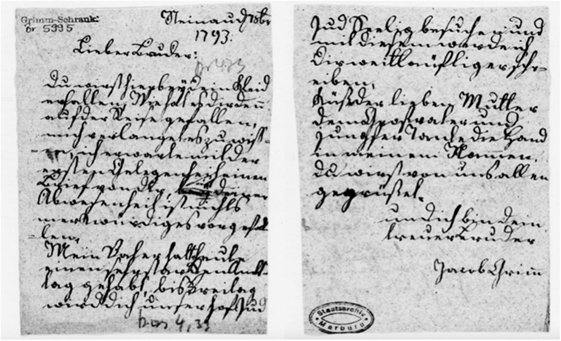
Figure 1. Letter written by Jacob Grimm at the age of 8 (Br 5995). A complete transcription of the letter can be read in the Appendix [Image reproduced with permission of the Hessisches Staatsarchiv Marburg].
Accordingly, we grouped letters by handwriting periods or epochs. This task produced four groups of letters per brother: 1793, 1800, 1805–06, 1814–63 for Jacob,9 and 1793, 1802–05, 1831–43, and 1846–59 for Wilhelm.
3.2.1.2. Readability
The letters were also sorted into four levels of readability: very low, low, medium, and high, as shown in Figure 2. Readability is affected by the quality of the paper (low quality paper reveals ink-spots) and by the legibility of the script. In consultation with Grimm experts,10 the readability categories of the Grimm handwriting were defined based on regularity, clearly distinguishable character length, and on the arbitrary omissions of final letters. One observation resulting from this analysis is that the early writing of both Jacob and Wilhelm is generally harder to read.
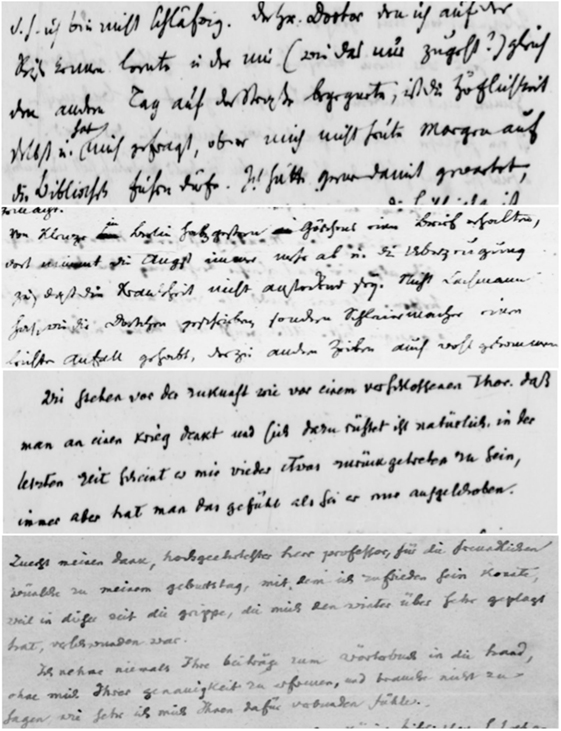
Figure 2. Four letters written by Wilhelm Grimm. From top to bottom: very low readability (Br 5993, 7 years old); low readability (Br 2680, 45 years old); medium readability (Br 2743, 73 years old); high readability (Br 2736, 69 years old) [Images reproduced with permission of the Hessisches Staatsarchiv Marburg].
As will become clear later, the division of these groups of letters was essential to generate an HTR model that would produce the lowest possible error rate.
This section describes the digitization of the Grimm correspondence using three different methods and compares the differing degrees of cleanliness of the latter two.
Both the manual and automatic transcriptions of the letters were carried out using the state-of-the-art software Transkribus.11 To build an HTR model that is able to automatically transcribe handwritten documents, Transkribus requires a minimum of 100 pages of manually transcribed text.12 The 85 manually transcribed letters13 varied in length—some are one page in length, some span multiple pages. The 50 letters by Jacob correspond to 90 pages of text, while the 35 letters by Wilhelm correspond to 64 pages, for a total of 154 manually transcribed pages.
As well as producing a diplomatic transcription of the letters,14 we annotated meta-information about the brothers’ calligraphy and the contents of the letters, as illustrated in Figure 3 (Jander, 2016).
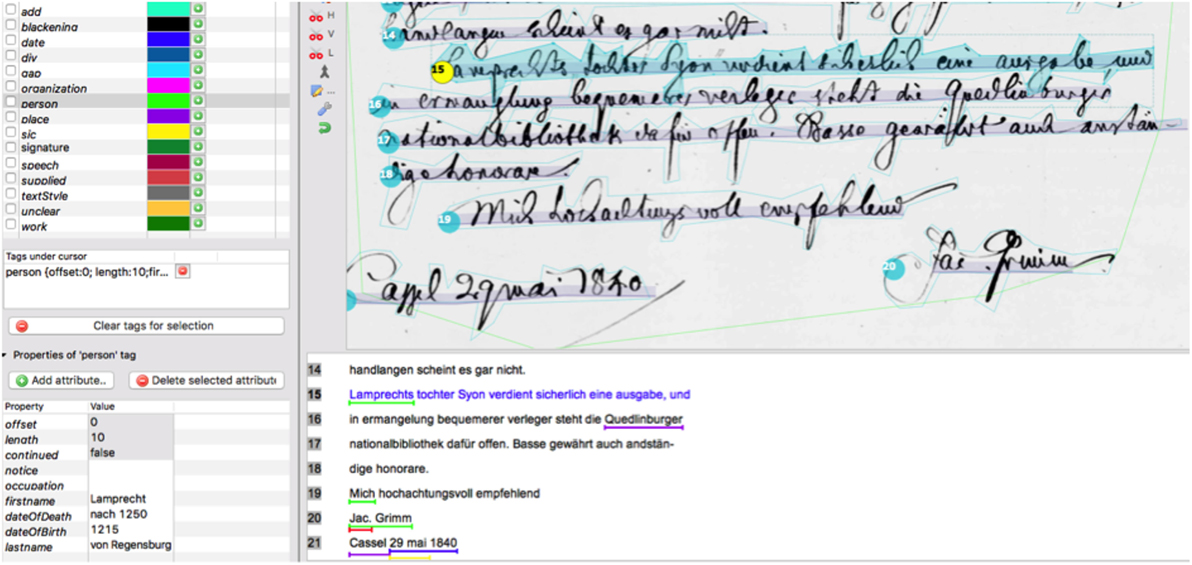
Figure 3. The Transkribus transcription environment. The screen is split into three areas: the left sidebar contains metadata and annotation functionality; the top area displays the original document (Br 2238, Jacob Grimm); and the bottom area contains the annotated transcription [Image reproduced with permission of the Hessisches Staatsarchiv Marburg].
The manual transcriptions were used to train a handwritten text recognition model that would be able to recognize and automatically transcribe other letters or documents written by the brothers (e.g., the 1,000 letters held in Berlin).
A reliable Transkribus HTR model needs a starting training set of, ideally, 100 manually transcribed pages of text.15 As the 85 letters of Jacob and Wilhelm Grimm added up to 154 pages, we were faced with a choice between running a model on the brothers combined in order to meet the HTR 100-page requirement or training two separate models, one per brother, on fewer pages (90 pages for Jacob and 64 pages for Wilhelm). A decision was made to test both scenarios and compare the results.16
4.1.2.1. First HTR Model
The first HTR run was performed on the 85 manually transcribed letters (154 pages) of Jacob and Wilhelm combined, for a total of 26,983 words. As well as meeting the minimum page count, our hypothesis behind combining two handwritings into the same training model was that a mixed model would prove more resistant to diachronic changes in Grimm handwriting. However, the character error rate (CER) obtained from this mixed model amounted to 18.83%, which means that every fifth character in the text was not correctly recognized. To improve the CER, we transcribed an additional 2,000 words of Grimm handwriting (corresponding to 17 pages). Against expectations, the new CER increased to approximately 40%, that is, an error for every 2.5 characters in the text. Upon closer inspection, we noticed that the high CERs were heavily influenced by 13 letters whose readability was very low. To reduce the CER, we, therefore, prepared a second HTR run in which we replaced those problematic 13 letters with 11 other documents written by the brothers (35 pages for a total of 5,788 words).17 Tables 3 and 4 list the discarded letters and the added documents, respectively.
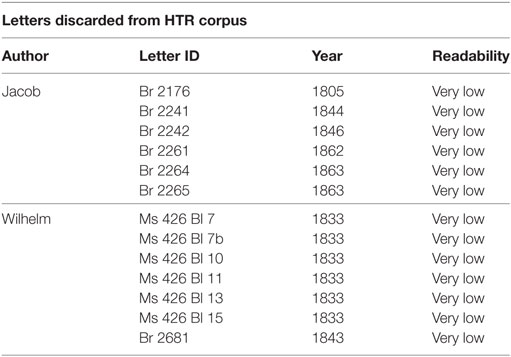
Table 3. Letters discarded from the HTR training corpus due to their very poor readability, which negatively affected the first HTR run.
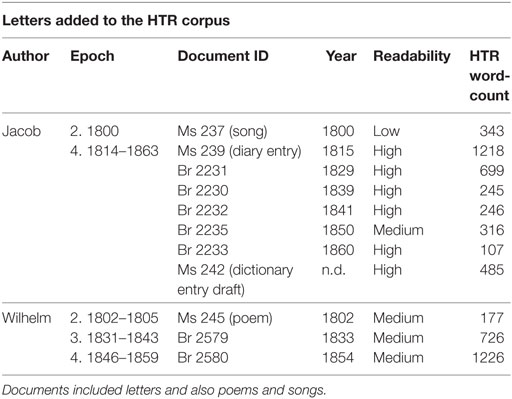
Table 4. The 11 documents added for the second run of the HTR to compensate for the loss of 13 letters from the previous run.
4.1.2.2. Second HTR Model
The second HTR run was thus performed on 83 documents, totaling 28,936 words (10,250 for Wilhelm and 18,686 for Jacob) and 128 pages (44 for Wilhelm and 84 for Jacob). In this run, Jacob and Wilhelm were trained separately with different training and test sets in a divide and conquer strategy, producing eight different runs (one per epoch per author). The intention in this run was to verify if smaller data-sets would produce more stable models. The results were encouraging, with an overall CER across the runs of <10%.
Below is an excerpt of the HTR transcription of Jacob’s letter “Br 2238” (dating to 1840) using the model trained on Jacob’s handwritten letters dating to the 1814–1863 period:
Text of the Original Letter
…handlangen scheint es gar nicht. Lamprechts tochter Syon verdient sicherlich eine Ausgabe, und in ermangelung bequemerer verleger steht die quedlinburger nationalbibliothek dafür offen. Rasse gewährt auch andständigehonorare. Mich hochachtungsvoll empfehlend Jac. Grimm
HTR Transcription [Errors Underlined]
…handlangen scheint es gar nicht. Lamprechts tochter von verdient sicherlich eine ausgabe und in ermangelung bgineneber verleger steht die quedlinburger natüoalbiblittchke der für offen. Rasse gewährt auch wurdendigehonorare mich hochachtungsvoll empfehlend Ihr. Grimm
The digitization and OCR of the seven volumes of the Grimm Briefwechsel edition produced seven output files.18 The text below is an example of noisy OCR output (letter Br 2238 by Jacob Grimm):
Handlangen scheint es gar nicht.
Lamprechts tochter Syon verdient sicherlich eine ausgabe, und in er-manglung bequemerer Verleger steht die Quedlinburger nationalbibliothek dafür offen. Basse gewaährt auch anständige honorare. Mich hochachtungsvoll empfehlend
Jac. Grimm.
As the reader will notice, the OCR preserved the edition’s carriage return hyphen in the word er-manglung, and the word Verleger is capitalized while in the print edition it is in lower case.
As Tables 5 and 6 show the accuracy of the OCR to be high with a median letter reaching above 91% clean words (above 98% correct characters).
Next, the cleanliness of the letters for which we had manual, OCR and HTR transcriptions was compared. The number of letters available in these three formats was 72. We considered the manual transcriptions a gold standard against which the cleanliness of the other versions was measured (see Table 5). While for HTR the differences only come from recognition errors, for OCR it may be both recognition errors and possible editorial interventions by Rölleke.
Depending on the stylometric type of analysis, cleanliness is assessed either on the percentage of misrecognized words (if we use words, word n-grams or lemmas as features in the authorship attribution/classification task) or of characters (if we use character n-grams), since any error in that respect changes the word/character/n-gram frequencies and can consequently alter the distances measured between texts (Burrows, 2002) (see Figure 4). A differing error rate between authors might also be problematic (see Table 6 and Figure 5).
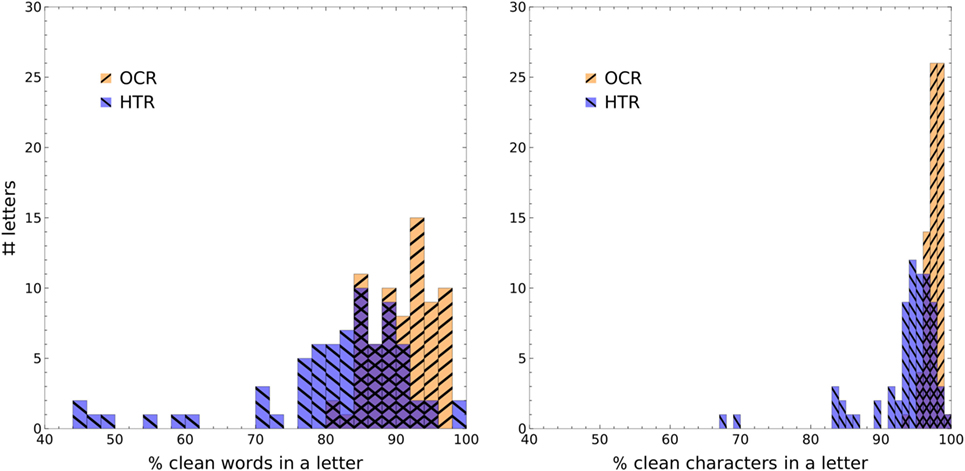
Figure 4. Histograms show the number of letters that have a given percentage of correctly recognized words/characters. Noticeably, HTR produces rather unstable results (the outliers to the left). For visibility, the overlap between two histograms is indicated by mixing their colors and adding a cross-pattern.
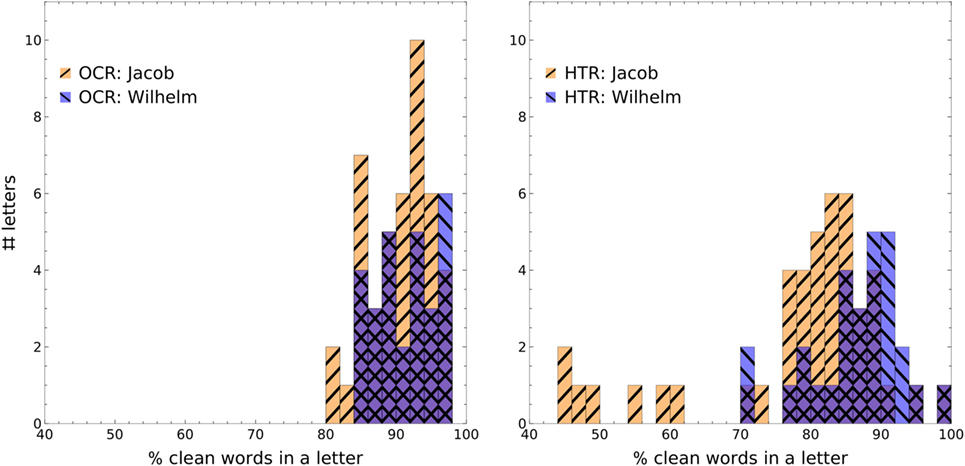
Figure 5. Histograms of letters divided by Jacob and Wilhelm. The right panel shows that it was Jacob’s writing that was more problematic for HTR.
In the first step, it might not be viable to scrutinize this influence on all the features. Instead, we report the influence of recognition errors on the lexical richness of the texts, and only then we continue with authorship attribution (Section 4.2). Lexical richness is not necessarily a good authorship indicator (Hoover, 2003), but it has a straightforward stylistic interpretation and it can illustrate possible issues with noisy data. Out of numerous richness scores (Tweedie and Baayen, 1998; Wimmer and Altmann, 1999) we used two: Shannon entropy, , and Simpson’s index (also called Inverse Participation Ratio, IPR) are both special cases of diversity indices (Hill, 1973), where T is the number of types and pt is the probability of occurrence of a type t (i.e., the number of occurrences of t divided by the number of all words in a text). Despite some criticism (Holmes, 1985; Thoiron, 1986) and the fact that they are very strongly (though non-linearly) correlated to one another, these indices are the simplest, the least arbitrary, and the theoretically best understood. For N being the number of tokens in the text, IPR ranges from 1/N to 1 (maximal richness and zero richness, respectively), it focuses more on the core of the word frequency distribution (the most frequent words), and so it stabilizes quickly with text length N; entropy, visualized in Figure 6, ranges from 0 to log N (zero and maximal richness), focuses on the tails of the word distribution (least frequent words like hapax legomena), which stabilize slowly and make it more sensitive to small changes as text progresses.
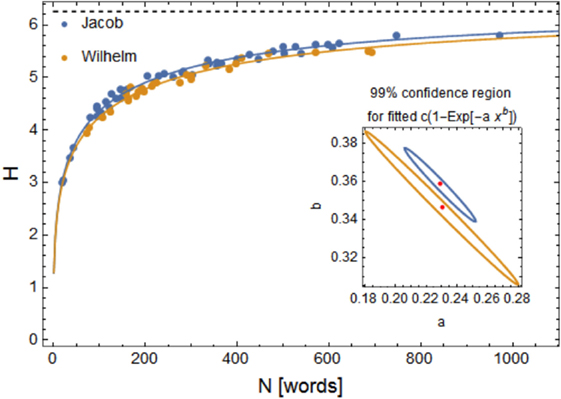
Figure 6. Entropy of Jacob’s and Wilhelm’s manually transcribed letters (points) shows that Jacob has a greater lexical diversity. The result is statistically significant at a 0.99 confidence level (see inset). The black dashed line represents the fitted asymptote c common to both curves.
One observation is that HTR produces enough errors to statistically and significantly yield lower richness per letter (p-values of paired T-tests are p = 1.04 × 10−7 and p = 8.03 × 10−6 for entropy and IPR, respectively); in some short letters this seems to be caused by HTR omitting or merging some words, which results in lower N, and—in the case of entropy—in lower log N. Otherwise, there are no statistical correlations between text richness and cleanliness of HTR or OCR. However, taking all the above into consideration, OCR seems a more viable option for stylometric measurements.
In order to test for the difference between the lexical richness of Jacob’s and Wilhelm’s letters we must circumvent the problem of the dependence of IPR and of the entropy on text length. We model it with an exponential function approaching a constant from below, which upon visual inspection, as shown in Figure 6, works well. Then, one may test for the difference between parameters of the fitted curves (inset in the Figure shows that they do differ).
In this section, we report on the authorship attribution task of modeling the individual writing styles of the Grimm brothers in the noisy digitized correspondence discussed above. We cast the modeling of their authorship as a categorization or classification experiment using Machine Learning (Sebastiani, 2002; Juola, 2008; Koppel et al., 2009; Stamatatos, 2009). We resorted to a standard binary classification routine, i.e., a Support Vector Machine (SVM) with a linear kernel, with its default settings as implemented in the well-known scikit-learn library (Pedregosa et al., 2011). Studies have shown that SVMs typically offer a strong baseline for authorship attribution (Stamatos, 2013), even in the face of extremely sparse input vectors. Because our data-set was small, we adopted a leave-one-out cross-validation procedure, where we iterated over all individual letters: in each iteration, one letter was set aside as a test instance, while the classifier was trained on the remaining training instances. Next, the trained model’s prediction as to the authorship of the held-out sample was recorded. We describe the performance of individual models using the established evaluation metrics accuracy and F1-score. With respect to this experimental procedure, it should be noted that this setup can be considered as a relatively unchallenging attribution problem because the number of authors is very limited (Luyckx and Daelemans, 2011; Eder, 2015) and the genre of the texts involved is relatively stable (Stamatos, 2013). The size of the data-set might be considered small from a Machine Learning point of view, but it is highly representative of the specific field of authorship studies, where small data-sets are very common, explaining the relative popularity of leave-one-out validation as an evaluation procedure. The length of the individual letters can be considered challenging, as most letters contain significantly fewer words that the minimal length thresholds previously discussed (Eder, 2015).
Here, we are especially concerned with the effect of different digitization modalities on attribution performance, i.e., the manually transcribed letters (MAN), automatic Handwritten Text Recognition on the original letters (HTR), and Optical Character Recognition on the original letters (OCR). Therefore, in our experiments we did not test our attribution models only within a single digitization modality, but also across the different modalities. As such, we aim to advance our understanding of directionality artifacts, i.e., the models built on the basis of one modality might scale relatively better to other modalities, which would make them more attractive for future projects. The base texts used in authorship studies typically have rather diverse origins and will often conflate materials coming from very different sources or editions or which result from different digitization modalities (e.g., OCR vs. HTR). An insight into these directionality effects would allow us to formulate very useful recommendations for future data collection efforts in the context of text classification.
In pre-processing, we lowercased all documents to reduce feature sparsity and we removed all salutations in the form of the brothers’ names that might interfere with the authorship task (e.g., W. in a phrase like Lieber W.). Each modality contained the exact same set of 72 letters for which some aggregate statistics are visualized in the plots in Figure 7. Most letters date from the second half of the period covered, although a number of youth letters are included too. The average letter length (expressed in word length) is ≈1,832, but the lengths show a considerable standard deviation (SD) (≈1,464). Note that Wilhelm (n = 28) is quantitatively outnumbered by his more prolific brother (n = 44). Character n-grams are a state-of-the-art text representation strategy in authorship studies and allowed our models to capture fine-grained, sub-word level information (Kestemont, 2014; Sapkota et al., 2015). We vectorized the data-sets with a standard TF-IDF weighted vector space model using a character n-gram feature extraction method that took into account the 5,000 most frequent n-grams (bigrams, trigrams, and tetragrams) with a minimal document frequency of 2. Finally, we applied row-wise L1-normalization to the resulting vectorization matrix for the entire data-set, followed by column-wise feature scaling as is customary in stylometry (Burrows, 2002).

Figure 7. General information about the subcorpus in this section: distribution of letters in terms of chronology, length, and authorship labels.
To assess the general performance of our model, we start by reporting leave-one-out scores for the setup discussed above on each data-set independently, where each letter subset (MAN, OCR, HTR) is individually vectorized. The confusion matrices are presented in Figure 8 and Table 7, which details the accuracy and F1-scores for each data-set. In general, the results are relatively high in terms of accuracy and F1, but certainly not perfect; the greedy SVM-tendency clearly over-attributes to Jacob, probably because of his relative prominence in the training data. The results for MAN and OCR are identical, whereas HTR seems to perform slightly worse already at this stage for both evaluation metrics.

Figure 8. Confusion matrices for the leave-one-out validation approach for each of the three data-sets.

Table 7. Leave-one-out validation results for intra-modality attribution in terms of accuracy and F1.
Upon a closer inspection of the predictions for MAN—which should in principle be the most reliable data source—in relation to the length and date of composition of the letters, we see that misattributions are, perhaps counter-intuitively, not restricted to shorter letters (see Figure 9). Given the overall chronological distribution of letters, we also see that misattributions seem to occur throughout the letter subsets.

Figure 9. Distribution of correct (true) and incorrect (false) predictions in the MAN data-set in terms of length, expressed in number of characters (left) and date (right).
Interestingly, whereas date or length do not appear to be decisive factors at this stage, Table S1 in Supplementary Material shows how it is in fact the same letters that tend to get misattributed across the different modalities. Whereas the attributions are fully consistent for OCR and MAN, we see that HTR behaves erratically in a small number of instances. Note how the data-sets also contain a number of extremely short letters (as short as eight words), which are nevertheless correctly attributed by some models—possibly because of the bias toward Jacob.
In digital literary studies, researchers frequently have to conflate textual materials of different origins and mix documents which have been digitized in multiple and not necessarily compatible modalities. While this practice is clearly sub-optimal, it is also often unavoidable. To assess the impact of the digitization modality on the results of authorship attribution we turned to a cross-modality experiment. To align the data-sets in terms of feature extraction, we vectorized all three data-sets simultaneously using the previous vectorization and extracting the 5,000 most frequent character n-grams. We ran the leave-one-out validation approach in the following manner: (1) We looped over each letter in the collection (which is present in each of the three data-sets) and set its three versions (MAN, OCR, HTR) apart as held-out items; (2) next, we trained three distinct classifiers on the remaining 71 letters in each subset; (3) finally, we instructed each of the three classifiers to make an attribution for each of the three held-out samples (9 predictions in total).
This procedure enables cross-modality performance, i.e., how well a classifier trained on one modality performs when tested on a different modality. In total, this yielded nine combinations of train-test modalities to compare (HTR→HTR, HTR→MAN, HTR→OCR, MAN→HTR, MAN→MAN, MAN→OCR, OCR→HTR, OCR→MAN, OCR→OCR), including the case where a single modality is used for training and testing (note, however, that the latter results might differ from those presented in the previous section, because of the different vectorization approach). Additionally, it is important to keep track of the directionality in these simulations, since the performance of moving from modality A in training to modality B in testing is not necessarily comparable to the inverse direction. Crucially, this setup might allow us to provide initial recommendations as to which modalities are to be preferred for the digitization and construction of training sets and test sets (which are not necessarily the same).
In the matrix in Figure 10, we present the outcome of this result in terms of misclassifications as a square matrix. Three observations can be made: the optimal combination is obtained when a system is trained and tested on manually transcribed data (0.07 error rate). Second, it is clear that systems trained on HTR’ed data do not perform well on either of the three test modalities and especially OCR (0.17 error), hinting at an aggravated effect of combined recognition errors. Third, OCR seems to do relatively well as a training modality; counter-intuitively, a system trained on OCR and tested on HTR performs even slightly better than a system trained on MAN. These hypotheses are visually supported in the agreement in Table S2 in Supplementary Material for the individual letters. Again, we see that it is typically the same letters that are misattributed in the different cross-modality setups. Nevertheless, this table also shows that it is typically the systems that involve the HTR modality that introduce inconsistencies on this level.
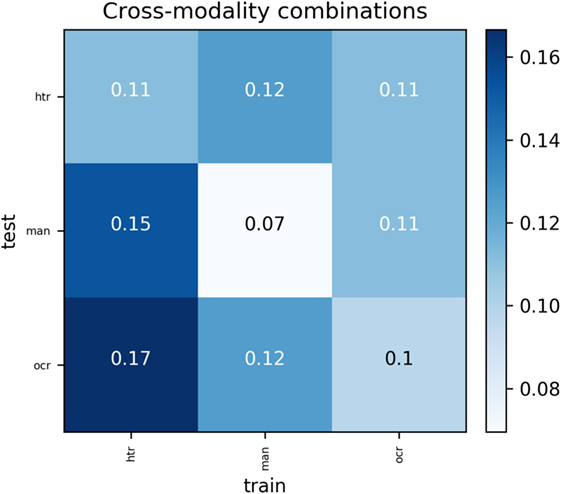
Figure 10. Outcome of the cross-modality experiments, presented as a square matrix showing misclassifications (error rate).
The differences between the different modality combinations showed a number of valuable emerging patterns, but these differences at times also became very small. We, therefore, turned to a significance testing to assess whether the differences observed for the different modality combinations are, statistically speaking, robust. Assessing the statistical significance of the outputs of different classifiers is a debated topic in Machine Learning, especially for small data-sets like the ones under scrutiny here, where the distribution of class labels is not known or cannot be properly estimated. Because of this, we turned to an approach known as “approximate randomization testing” (Noreen, 1989). This non-parametric test is common in computational authorship studies, such as the PAN competition (Stamatatos et al., 2014), to compare the output of two authorship attribution systems, where we cannot make assumptions about the (potentially highly complex) underlying distributions. The test outputs a score that helps us to assess whether the output of two binary classification systems is statistically significant with respect to the F1-score metric. These individual scores represent the probability of failing to reject the null hypothesis (H0) that the classifiers do not output significantly different scores.
These scores are represented in a tabular format in Figure 11. This figure largely confirms our previous observations: systems trained on HTR perform comparatively worse and their outputs do not significantly diverge from each other. As shown by the darker rows and columns, combinations involving HTR typically invite decidedly different results from those involving (only) MAN or OCR. The lighter cells additionally justify the hypothesis that in many cases combinations involving OCR do not diverge strongly from the MAN subset. This suggests that OCR digitization at this stage can serve as a fairly reliable proxy for the more painstaking MAN digitization, at least when it comes to authorship attribution.
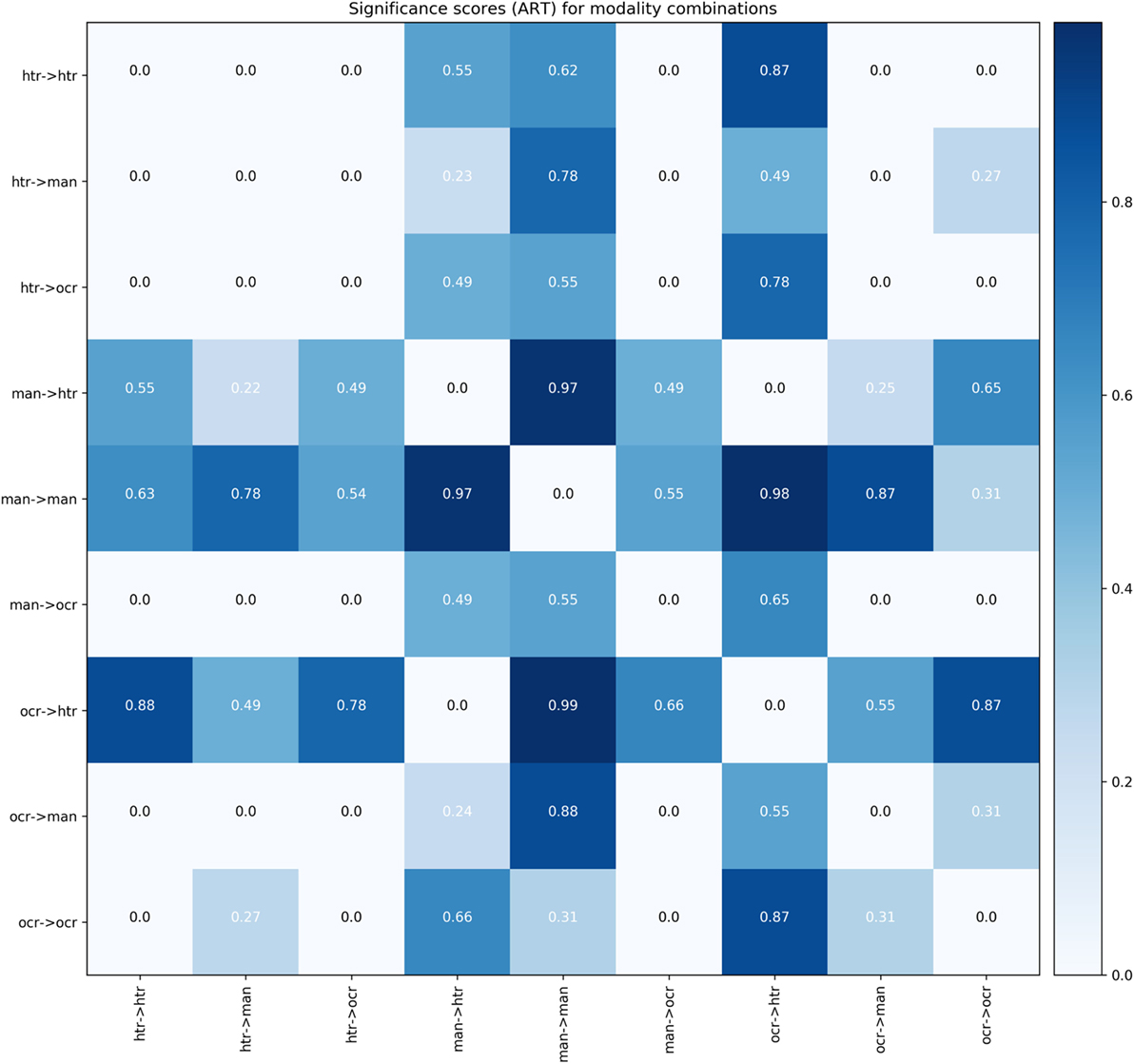
Figure 11. Tabular representation of the scores yielded for the outputs of different modality combinations in attribution. Higher scores indicate that two systems produce significantly different outputs.
The experiment reported here was designed to verify whether there is any relationship between the success of binary authorial attribution of the letters of the Grimm brothers (i.e., attributing authorship either to Jacob or to Wilhelm) and the quality of the automated text recognition (OCR or HTR). In this section, the attribution takes place across modalities, with the manual transcription as the training set and either OCR or HTR as the test set.
Instead of correlating the cleanliness (see Section 4.1.4) of the existing letters with the classification results, we decided to exploit more fine-grained information and to improve the statistical properties of the corpus by random sampling. The training set was constructed from the manually transcribed letters by random sampling individual lines, so that the resulting corpus included 72 texts randomly generated via an approach similar to “bag of words” (44 based on lines randomly sampled from Jacob’s and 28 from Wilhelm’s letters), each of at least 1,500 characters (roughly 250 words) in length. This allowed us to normalize the samples while concurrently retaining some realistic properties of the original data-set. Next, another random text (1,500 characters long) was sampled from lines of an automatically transcribed set (either OCR or HTR) in such a way that we could track its total cleanliness (ratio of correctly transcribed characters) and classify it (here, with Burrows delta and 100 most frequent words). The whole procedure (generation of training and test set and classification) was repeated for each author and automatic transcription method to reach a total of 3,800 random samples characterized by their cleanliness (0–100%) and classification result (0 or 1, for incorrect or correct attribution). These data points could then be analyzed by means of probit regression, as illustrated in Figure 12.
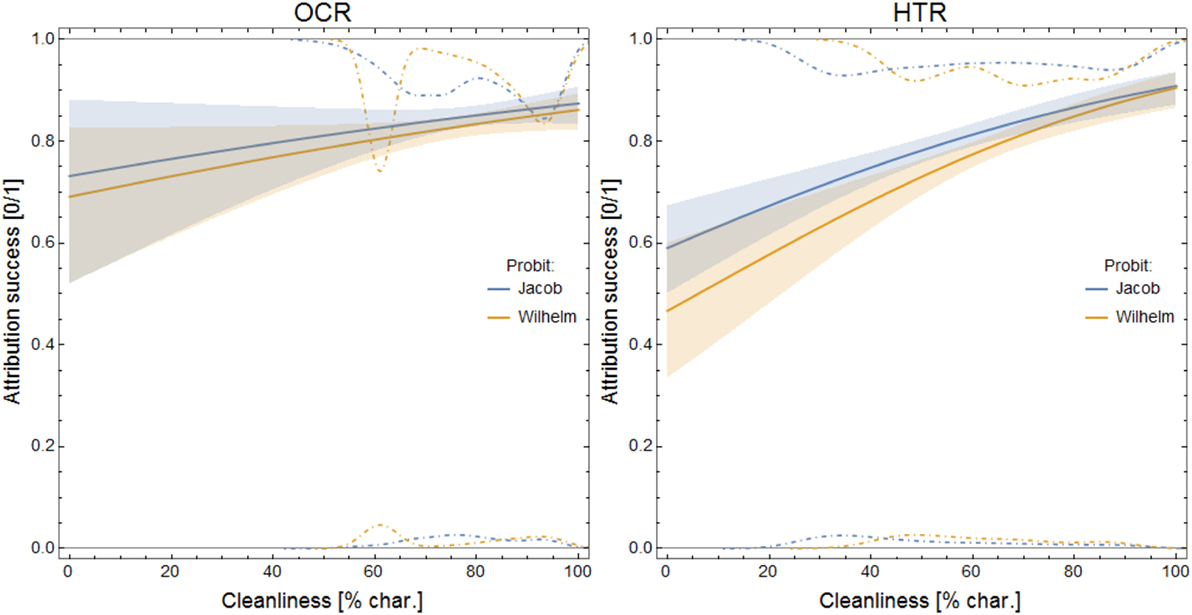
Figure 12. Probit models (continuous lines) fitted to randomly sampled texts; the shaded regions are 0.95 confidence boundaries. Dot-dashed lines indicate relative number of samples attributed: (top) correctly and (bottom) erroneously. Note that the upper histograms are upside down. For instance, in the OCR case, most of Wilhelm’s samples are 60 or 95% clean (peaks in the upper histogram), and at 60% cleanliness there are five times as many correct as incorrect attributions (upper relative to the lower peak height).
The result depends on the training set (and possibly on the relative sizes of the brothers’ subsets therein). We checked that the fitted models shown in Figure 12 hold for equally sized subsets as well. For a small number of samples (a few hundred) the results were still unreliable, but the several thousands were enough to produce a convergent, stable result. The results show that there is only a marginally significant relation between cleanliness and attribution success for OCR (at 0.95, but not at 0.99 confidence level), and there is a significant (0.99 confidence level) relation for HTR in both Wilhelm’s and Jacob’s writing: the cleaner their texts are, the more probable correct attribution is. It is noteworthy that cleanliness above ≈20% is already enough for HTR to have a higher-than-chance probability of correct attribution (for OCR the probability is always higher-than-chance).
This article describes the impact of digitization noise on the automatic attribution of a body of letters to Jacob and Wilhelm Grimm.
Accordingly, to test all possible digitization scenarios, we prepared three different digitization outputs to compare: (1) manual transcriptions of the original letters, (2) the OCR of a 2001 printed critical edition of the Grimm letters, and (3) an HTR model for the automatic transcription of the original letters. The manual transcription was used as a gold standard for the evaluation of the cleanliness of the OCR and the HTR output. As expected, the HTR error rate was higher than OCR due to the instability of handwriting as opposed to the uniformity of print. Nevertheless, our experiments showed that despite our imperfect data-set for HTR processing, the generated models for the Grimm brothers averaged <6% character error rate (i.e., an error every 17 characters).
Such an error rate is already high enough to significantly lower the vocabulary richness of the HTR’ed letters. Since this measure is a distinctive factor the both brothers, we also tested the adequacy of the three different digitization outputs—manual transcription, noisy OCR, and noisy HTR—for authorship attribution. What we found was that OCR digitization served as a reliable proxy for the more painstaking manual digitization, at least when it comes to authorship attribution.
Interestingly, it appears that the attribution is viable even when the training and test sets were built from differently digitized texts. With regards to HTR, our research demonstrates that even though automated transcription significantly increases the risk of text misclassification in comparison to OCR, a cleanliness of above ≈20% is already enough for it to have a higher-than-chance probability with respect to a binary attribution task (for OCR the probability is always higher-than-chance).
While still preliminary, our results add further support to the argument that absolute text cleanliness is not a major prerequisite for authorship attribution (Eder, 2015), or at least not in the case of the letters written by the Grimm brothers discussed here. Our HTR model is the first model of the Grimms’ handwriting to have been produced and one that can be refined if trained on more handwritten documents (e.g., the set of professional letters currently housed in Berlin). Looking ahead, a next research avenue might be the cross-genre authorship verification of the Grimm’s Kinder und Hausmärchen to identify, if at all possible, which (parts of the) fairy tales are more markedly Jacob or Wilhelm.
EF and GF are co-responsible for data acquisition and project setup. GR coordinated the manual transcription and, together with MJ, transcribed the letters. GR also jointly oversaw the OCR and HTR of the letters. MK, JO, JB, and JR designed and performed the computational analyses. GF, GR, EF, MJ, MK, and JO wrote sections of the manuscript. GF put together the first draft of the manuscript and brought it to completion. All authors contributed to manuscript revision, read and approved the submitted version.
The authors declare that the research was conducted in the absence of any commercial or financial relationships that could be construed as a potential conflict of interest.
The reviewer FB and handling Editor declared their shared affiliation.
The authors wish to thank colleagues Maria Moritz, Kirill Bulert, Marco Büchler, and former colleague Linda Brandt for their valuable contribution to the project. We also wish to thank Bernhard Lauer and Rotraut Fischer of the Brüder Grimm-Gesellschaft e.V in Kassel, Germany, for their expert advice and input on the calligraphy of the Grimm brothers. We thank Dr Stephan Tulkens for his kind support in the research for Section 4.2.3, and Dr Günther Mühlberger for his crucial contribution in HTR modeling of the Grimm handwriting. Finally, special thanks go out to Professor Gerhard Lauer for his continuous guidance and support.
This research project was funded by the “Interessenbekundung zur Themenbesetzung im Campuslabor Digitalisierung” initiative of the University of Göttingen (Projekt: 392860 “Campuslabor”). Authors affiliated with the University of Göttingen are employed under grant no. 01UG1509 awarded by the German Federal Ministry of Education and Research (BMBF).
The Supplementary Material for this article can be found online at https://www.frontiersin.org/articles/10.3389/fdigh.2018.00004/full#supplementary-material.
Table S1. Overview of the prediction for the three intra-modality models.
Table S2. Outcome of the cross-modality experiments, showing the agreement between different combinations for individual letters.
Agarwal, S., Godbole, S., Punjani, D., and Roy, S. (2007). How much noise is too much: a study in automatic text classification. In Seventh IEEE International Conference on Data Mining (ICDM 2007), 3–12. Omaha, NE, USA: IEEE.
Burrows, J. (2002). “Delta”: a measure of stylistic difference and a guide to likely authorship. Literary and Linguistic Computing 17: 267–87. doi: 10.1093/llc/17.3.267
Eder, M. (2013). Mind your corpus: systematic errors in authorship attribution. Literary and Linguistic Computing 28: 603–14. doi:10.1093/llc/fqt039
Eder, M. (2015). Does size matter? Authorship attribution, small samples, big problem. Literary and Linguistic Computing 30: 167–82. doi:10.1093/llc/fqt066
Eder, M. (2017). Short samples in authorship attribution: a new approach. In Digital Humanities 2017: Conference Abstracts, 221–224. Montréal, Canada.
Fink, F., Schulz, K.U., and Springmann, U. (2017). Profiling of OCR’ed historical texts revisited. In In Conference on Digital Access to Textual Cultural Heritage (DATeCH ’17), 59–66. Göttingen, Germany: EACL.
Halteren, H.V., Baayen, H., Tweedie, F., Haverkort, M., and Neijt, A. (2005). New machine learning methods demonstrate the existence of a human stylome. Journal of Quantitative Linguistics 12: 65–77. doi:10.1080/09296170500055350
Hill, M.O. (1973). Diversity and evenness: a unifying notation and its consequences. Ecology 54: 427–32. doi:10.2307/1934352
Holmes, D.I. (1985). The analysis of literary style – a review. The Journal of the Royal Statistical Society 148: 328–41. doi:10.2307/2981893
Hoover, D.L. (2003). Another perspective on vocabulary richness. Computers and the Humanities 37: 151–78. doi:10.1023/A:1022673822140
Jander, M. (2016). Handwritten Text Recognition – Transkribus: A User Report. Göttingen, Germany: eTRAP Research Group, University of Göttingen.
Juola, P. (2008). Authorship attribution. Foundations and Trends in Information Retrieval 1: 233–334. doi:10.1561/1500000005
Kestemont, M. (2014). Function words in authorship attribution. From black magic to theory? In Third Computational Linguistics for Literature Workshop, 59–66. Gothenburg, Sweden: European Chapter of the Association for Computational Linguistics.
Kjell, B. (1994). Discrimination of authorship using visualization. Information Processing and Management 30: 141–50. doi:10.1016/0306-4573(94)90029-9
Koppel, M., Schler, J., and Argamon, S. (2009). Computational methods in authorship attribution. Journal of the American Society for Information Science and Technology 60: 9–26. doi:10.1002/asi.20961
Lopresti, D. (2009). Optical character recognition errors and their effects on natural language processing. International Journal on Document Analysis and Recognition (IJDAR) 12: 141–51. doi:10.1007/s10032-009-0094-8
Luyckx, K., and Daelemans, W. (2011). The effect of author set size and data size in authorship attribution. Literary and Linguistic Computing 26: 35–55. doi:10.1093/llc/fqq013
Noreen, E.W. (1989). Computer-Intensive Methods for Testing Hypotheses: An Introduction. New York: John Wiley and Sons.
Pedregosa, F., Varoquaux, G., Gramfort, A., Michel, V., Thirion, B., Grisel, O., et al. (2011). Scikit-learn: machine learning in Python. Journal of Machine Learning Research 12: 2825–30.
Press, G. (2016). Cleaning Big Data: Most Time-Consuming, Least Enjoyable Data Science Task, Survey Says. Available at: https://www.forbes.com/sites/gilpress/2016/03/23/data-preparation-most-time-consuming-least-enjoyable-data-science-task-survey-says/#5f6ea6516f63 (Accessed: March 17, 2018).
Sapkota, U., Bethard, S., Montes, M., and Solorio, T. (2015). Not all character n-grams are created equal: a study in authorship attribution. In Proceedings of the 2015 Conference of the North American Chapter of the Association for Computational Linguistics: Human Language Technologies, 93–102. Denver, Colorado: Association for Computational Linguistics.
Sebastiani, F. (2002). Machine learning in automated text categorization. ACM Computing Surveys 34: 1–47. doi:10.1145/505282.505283
Stamatos, E. (2013). On the robustness of authorship attribution based on character n-gram features. Journal of Law and Policy 21: 421–39.
Stamatatos, E. (2009). A survey of modern authorship attribution methods. Journal of the Association for Information Science and Technology 60(3): 538–56. doi:10.1002/asi.21001
Stamatatos, E., Daelemans, W., Verhoeven, B., Stein, B., Potthast, M., Juola, P., et al. (2014). Overview of the author identification task at PAN 2014. In Working Notes for CLEF 2014 Conference, Sheffield, UK, September 15-18, 2014, 877–897. Sheffield.
Subramaniam, L.V., Roy, S., Faruquie, T.A., and Negi, S. (2009). A survey of types of text noise and techniques to handle noisy text. In The Third Workshop on Analytics for Noisy Unstructured Text Data, 115–122. New York, USA: ACM.
Thoiron, P. (1986). Diversity index and entropy as measures of lexical richness. Computers and the Humanities 20: 197–202. doi:10.1007/BF02404461
Tweedie, F.J., and Baayen, R.H. (1998). How variable may a constant be? Measures of lexical richness in perspective. Computers and the Humanities 32: 323–52. doi:10.1023/A:1001749303137
Vobl, T., Gotscharek, A., Reffle, U., Ringlstetter, C., and Schulz, K.U. (2014). PoCoTo – an open source system for efficient interactive postcorrection of OCRed historical texts. In First International Conference on Digital Access to Textual Cultural Heritage (DATeCH ’14), 57–61. Madrid, Spain: EACL.
Wimmer, G., and Altmann, G. (1999). Review article: on vocabulary richness. Journal of Quantitative Linguistics 6: 1–9. doi:10.1076/jqul.6.1.1.4148
Manual transcription of Jacob Grimm’s letter dating 1793.
Montag
Steinau den 7 8br 1793.
Lieber Bruder!
Du wirst hierbey dein Kleid erhalten, Wie hatt es dir denn auf der Reise gefallen, mich verlanget es zu wissen, ich erwarte mit der ersten Gelegenheit einen Brief von dir, seit deiner Abwesenheit ist nichts merkwürdiges vorgefallen.
Mein Vater hatte heute einen sehr starken Amtstag gehabt, bis Freitag wird dich unser hofjud Jud Seelig besuchen und mit diesem werde ich dir weitläufliger schreiben, Küβe der lieben Mutter dem Groβvater und jungfer Tante die Hand in meinem Nammen. Du wirst von uns allen gegrüβet, und ich bin dein treuer Bruder
Jacob Grimm
Keywords: stylometry, authorship attribution, German literature, Grimm, digitization, OCR, HTR, digital humanities
Citation: Franzini G, Kestemont M, Rotari G, Jander M, Ochab JK, Franzini E, Byszuk J and Rybicki J (2018) Attributing Authorship in the Noisy Digitized Correspondence of Jacob and Wilhelm Grimm. Front. Digit. Humanit. 5:4. doi: 10.3389/fdigh.2018.00004
Received: 14 December 2017; Accepted: 08 March 2018;
Published: 05 April 2018
Edited by:
Simonetta Montemagni, Consiglio Nazionale Delle Ricerche (CNR), ItalyReviewed by:
Laurence Mellerin, Centre national de la recherche scientifique (CNRS), FranceCopyright: © 2018 Franzini, Kestemont, Rotari, Jander, Ochab, Franzini, Byszuk and Rybicki. This is an open-access article distributed under the terms of the Creative Commons Attribution License (CC BY). The use, distribution or reproduction in other forums is permitted, provided the original author(s) and the copyright owner are credited and that the original publication in this journal is cited, in accordance with accepted academic practice. No use, distribution or reproduction is permitted which does not comply with these terms.
*Correspondence: Mike Kestemont, bWlrZS5rZXN0ZW1vbnRAdWFudHdlcnBlbi5iZQ==
Disclaimer: All claims expressed in this article are solely those of the authors and do not necessarily represent those of their affiliated organizations, or those of the publisher, the editors and the reviewers. Any product that may be evaluated in this article or claim that may be made by its manufacturer is not guaranteed or endorsed by the publisher.
Research integrity at Frontiers

Learn more about the work of our research integrity team to safeguard the quality of each article we publish.